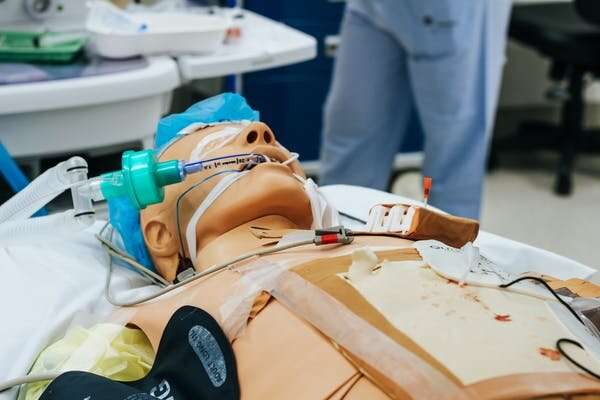Simulations with actors prepare nurses for the demands of their profession


Now more than ever, it is essential that post-secondary nursing programs train students to deal with real-world scenarios. The sudden onset of COVID-19 has further highlighted the critical role nurses play in our health system. What role can professional actors play in preparing nursing students to handle these demands?
At MacEwan University, our nursing science program uses theater graduates to play standardized patients in clinical simulations. In a typical simulation, the instructor asks the actor to improvise a situation that the nursing students may face in their professional practice. After each simulation, the instructor leads a debriefing session to help nursing students reflect on what worked and what they can improve on.
Benefits of using actors
According Cynthia Gundermann, who co-ordinates theater students in the simulation program, her students benefit greatly from working with the actors. “When our learners can suspend their disbelief and fully engage with the portrayed characters, they are able to gain richer and more meaningful learning from their simulation events.”
To help the students buy into the simulations, the actors use Russian theater actor Constantin Stanislavski’s psychological realism techniques to create believable patients. “The most important thing is to be authentic,” explained theater graduate Dempsey Bolton. “Working with actors is the closest students can get to a real-world situation.”
Research demonstrates that role-play with actors enhances the realism of clinical simulations. One study conducted with the Program to Enhance Relational and Communication Skills (PERCS) noted that 98 percent of 192 learners and 97 percent of 33 faculty members described the actors’ portrayals of patients as realistic. In addition, 97 percent of learners and 100 percent of faculty agreed that the use of actors was valuable to learning.
The actors also use renowned acting teacher Stella Adler’s theories on character development to portray patients with a wide range of physical, psychological and socioeconomic characteristics. This helps the students better understand how to treat patients with diverse worldviews, backgrounds and prejudices. Theater graduate Jarrod Smith said exploring patients’ backstories helps him “put flesh on their bones,” resulting in more truthful performances. “I want to know what my characters ate for lunch,” said Smith jokingly.
In addition, the actors draw on American theater coach Sanford Meisner’s listening and improvisation exercises to interact with nursing students without the need for a scripted text. This helps students develop communications skills and the ability to think on their feet. Similarly, research by Sigall K. Bell and others found that learners valued the actors’ flexibility in their approach to conversation.

The actors also use techniques developed by Uta Hagen to realistically express intense emotions such as grief, fear, anxiety, sadness and anger. Interacting with patients in emotional distress helps nursing student develop empathy and teaches them to balance both the patient’s physical and psychological needs.
Nursing instructors like working with actors because they are able to instantly incorporate feedback in simulations, just as they would a theater director’s notes in rehearsals. “In theater school we were encouraged to embrace constructive criticism just as much as praise,” said graduate Kendra Sargeant. “When a director gives me a note, I’m able to integrate it into my performance immediately.”
The use of professional actors in simulations does not only benefit the nursing students. “It’s a beneficial relationship on both ends,” said Smith. “It’s an opportunity to dust off my acting chops between shows.” Working in simulations also gives Smith a sense of purpose, knowing he is contributing to society in a positive way. “It’s rewarding know that you’re helping someone who’s going to be a nurse one day.”
Challenges of simulation work
While performing in simulations is gratifying, the actors experience a few challenges. It can be difficult to maintain a sense of spontaneity when acting the same scenario repeatedly, albeit for different students. “Keeping it fresh is definitely a challenge,” said Bolton.
In addition, Sargeant confessed that the repetitive nature of the work can be emotionally taxing. Smith agreed: “Going to extreme emotional places throughout an eight hour day can be pretty draining.” Research indicates that some actors depicting mental illnesses, such as depression, have difficulty shaking off such feelings, even days after the simulations.
Another challenge is that sometimes the actors are required to act opposite a mannequin. This can elicit understandable giggles from the nursing students. Therefore the actors must rely on their acting chops to help them treat the mannequin as if it were a real human being. “When we’re engaged, it’s easier for the students to be engaged,” said Smith.
Source: Read Full Article